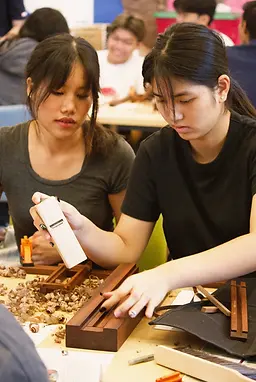

Chopstick Making
Make Your Own Chopsticks: A Taste of Woodworking is a unique, hands-on woodcrafting experience where participants are taught how to safely use a Japanese hand plane and guided through the chopstick shaping process with custom designed, hand built wooden jigs and fixtures.
Through stories of dining cultures from different countries, this workshop explores the chopstick design process in a way that stimulates deeper cultural understanding and illustrates how a simple utensil can actually act as a manifestation tool towards cultivating community and connection. Participants are encouraged to reflect inward as they customize and shape their chopsticks to better align with the lifestyle they wish to embody moving forward.

KEY FEATURES
-
Workshops typically last between three to four hours
-
All tools and materials provided
-
No prior woodworking experience needed
-
Accessible to those with visual impairments
-
Max. 12 participants per session (multiple sessions can be arranged for larger groups)
-
Ages 13+ only

location
The workshop can be hosted at your venue (as we coordinate I can visit your site to confirm compatibility), or I can work with you to secure an alternate venue. I’m based in Los Angeles (Koreatown) but may be open to traveling depending on distance and capacity.
Workshop Facilitation Fee
Rates vary based on participant count, group structure (single/multiple sessions), and selected add-ons. All tools and materials are provided and prepared by me, which is reflected in the rate. Once you submit the inquiry form below, I’ll respond with a personalized quote.

QUESTIONS?

Email me at ali@alichenstudio.com. Thank you!

CALENDAR
Check out when I'll be hosting my next workshop!
BOOK A WORKSHOP

Whether you’re looking to book an exclusive private workshop, an elevated team bonding experience, or a public workshop offering for your community, there’s something for everyone.
My availability is open for 2026 dates.
If you’re interested in booking a workshop with me, please submit an inquiry below and I will reach out to you with more information regarding customization, availability, and pricing.
Chopstick
care & maintenance
Chopsticks are to be hand washed only, with cold water and soap. Please do NOT place your hand crafted chopsticks into the dish washer, as they will warp.
Please avoid soaking the chopsticks in any liquids.
After some use, chopsticks will begin to show signs of wear (dry, dull, rough) and will require maintenance in order to look good as new. Below are maintenance instructions based on the available finish options from the workshop:

Butcher Block Conditioner
This is a blend of beeswax, Brazilian carnauba wax, and food grade mineral oil. It provides slight water resistance.
Upon signs of wear, you can:
-
Shake the mixture to ensure contents are mixed.
-
Squeeze a small amount onto a rag and wipe the conditioner onto chopsticks.
-
Allow the conditioner to soak in for a bit (up to 30 minutes recommended but could be sooner) before wiping off with a clean rag until the wood feels dry to the touch.
-
The longer you allow the finish to soak in, the deeper the finish will penetrate the wood.
food grade
mineral oil
Food grade mineral oil is vegan as it doesn't contain beeswax. It is non-toxic and food safe despite being derived from petroleum because it's been refined to remove harmful compounds.
Upon signs of wear, you can:
-
Either rub the oil onto the chopsticks with a small cloth, or submerge your chopsticks into a food grade mineral oil bath (up to 20 minutes recommended but could be sooner).
-
Wait a few minutes and then wipe off oil using a clean cloth, until wood feels dry to the touch.
-
The longer you submerge your chopsticks in the oil, the deeper the finish will penetrate the wood.


unfinished
Wood is naturally antibacterial and antimicrobial, and technically does not require a finish application.
Upon signs of wear, you can:
-
Lightly re-sand the chopsticks until they're smooth again.
-
Go from 180 grit to 220 grit to 320 grit.
-
If you want your eating tip to grip your food better, you can sand just the eating tip with 180 grit or lower (100 grit, 80 grit) and not go any higher in grit. The lower the grit the better the grip.
